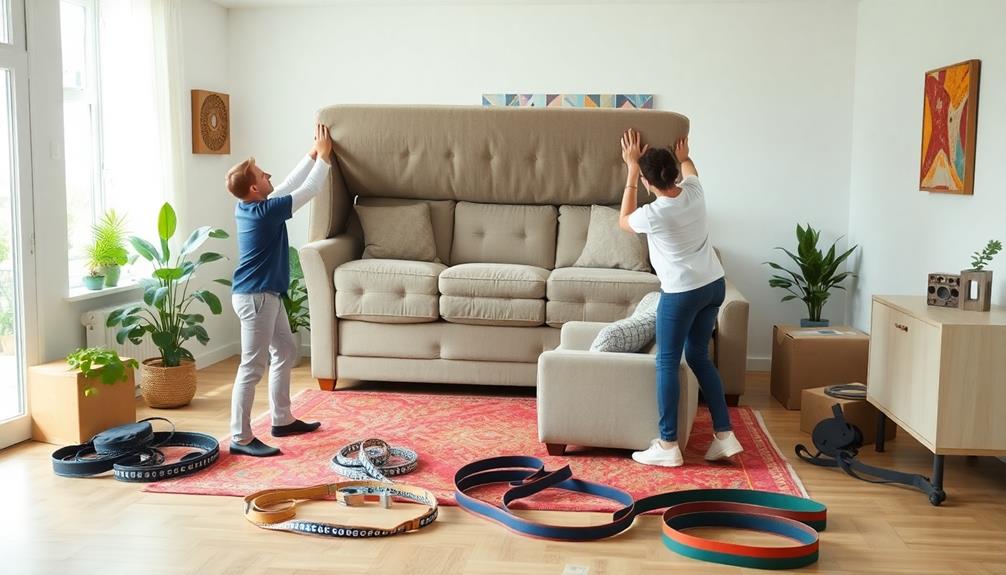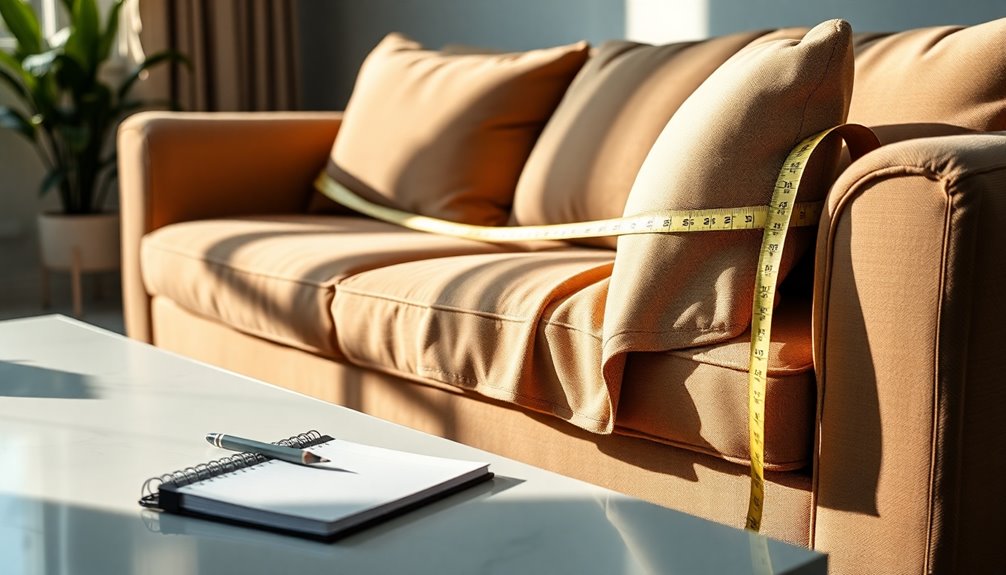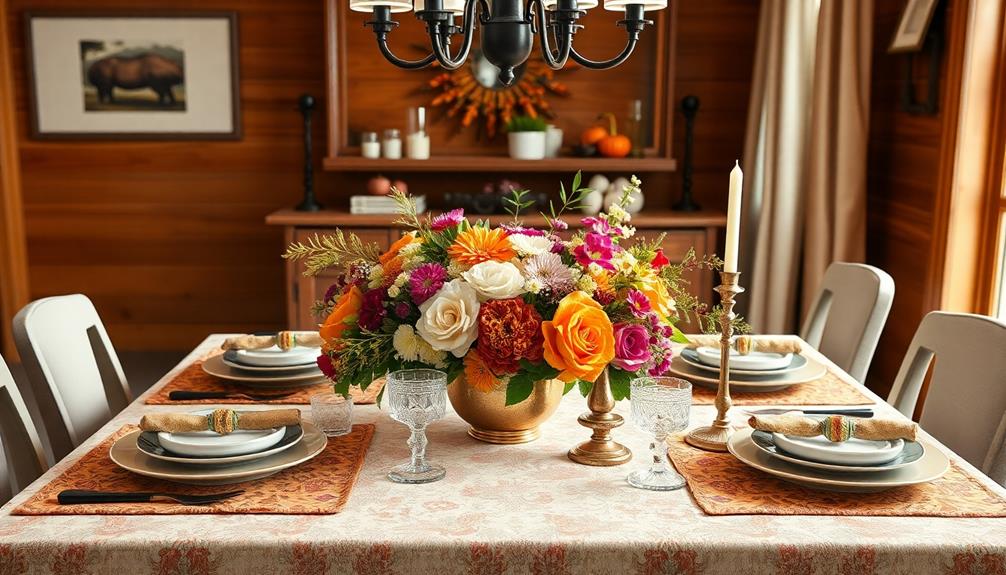In order to move furniture safely and effectively, it is important to start by planning out your route and measuring your items. Clear any pathways by removing obstacles and gather necessary supplies such as moving blankets and dollies. If needed, disassemble large pieces to make them easier to transport. It is crucial to utilize proper lifting techniques – bend at the knees and keep your back straight – in order to prevent injury. Always communicate with your helpers and consider using equipment like furniture sliders for heavy items. After everything has been moved, inspect for any damage and arrange your furniture according to your planned layout. There is always more to learn to ensure a smooth moving experience ahead.
Key Takeaways
- Plan your route and measure furniture to ensure safe passage through doorways and stairs.
- Disassemble heavy items to reduce weight and enhance safety during transport.
- Use proper lifting techniques and communicate clearly with your helpers for efficient teamwork.
- Protect furniture with moving blankets and secure them with stretch film to prevent damage.
- Utilize equipment like dollies and furniture sliders to ease the movement of heavy items.
Preparation Steps for Moving
When you're preparing to move furniture, the first step is to plan your route carefully. Map out pathways, noting any narrow doorways or stairs that could pose challenges when you're trying to move heavy items. For instance, if you have a vehicle, remember that fuel injection cleaning can improve its performance, making your moving experience smoother.
Measure both your furniture and these access points to see if disassembly is necessary; this can greatly ease the moving process.
Next, clear your pathways of obstacles like rugs or other furniture. Creating a safe, unobstructed route is essential for transporting heavy items without accidents.
Gather essential moving supplies, such as moving blankets to protect your belongings, dollies for easier transport, and furniture sliders to help glide heavy pieces across floors.
Don't forget to enlist the help of at least two additional people. Lifting and maneuvering heavy furniture is much easier and safer with extra hands. Make sure everyone knows their roles to boost efficiency during the move.
With careful planning and the right tools, you can navigate your space confidently and guarantee that your furniture arrives at its new location without damage.
Disassembly Techniques
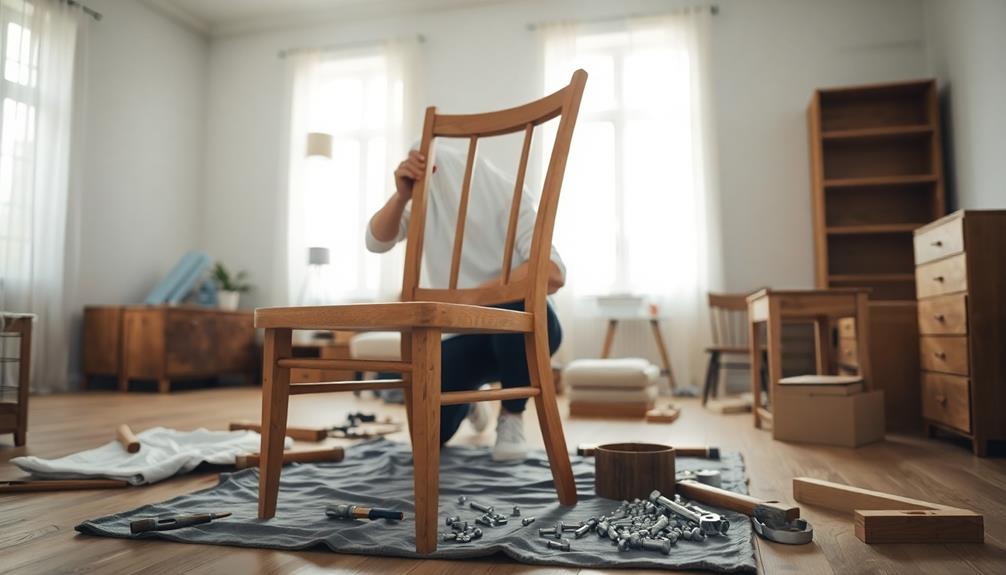
Disassembling furniture can make your move smoother and safer, especially for larger pieces that can be cumbersome to navigate. Start by using appropriate tools like screwdrivers, hex wrenches, or pliers to carefully take apart items. For tables and chairs, remove legs to considerably reduce weight, making them easier to handle.
Additionally, ensuring that your heat pump is functioning well can help maintain a comfortable environment while you work on your move; features of the ultimate heat pump can enhance temperature regulation during this hectic time.
When dealing with box springs, remove the fabric covering and cut along the middle crosspiece to allow for folding. This technique simplifies transport and handling, making it easier to fit through tight spaces. Remember to keep small parts like screws and brackets organized in ziplock bags to prevent loss during the move.
For heavy items like armoires or entertainment centers, disassembling them can be essential. Not only does it help you navigate tight spaces and doorways more effectively, but it also enhances safety during the move.
Safe Lifting Methods
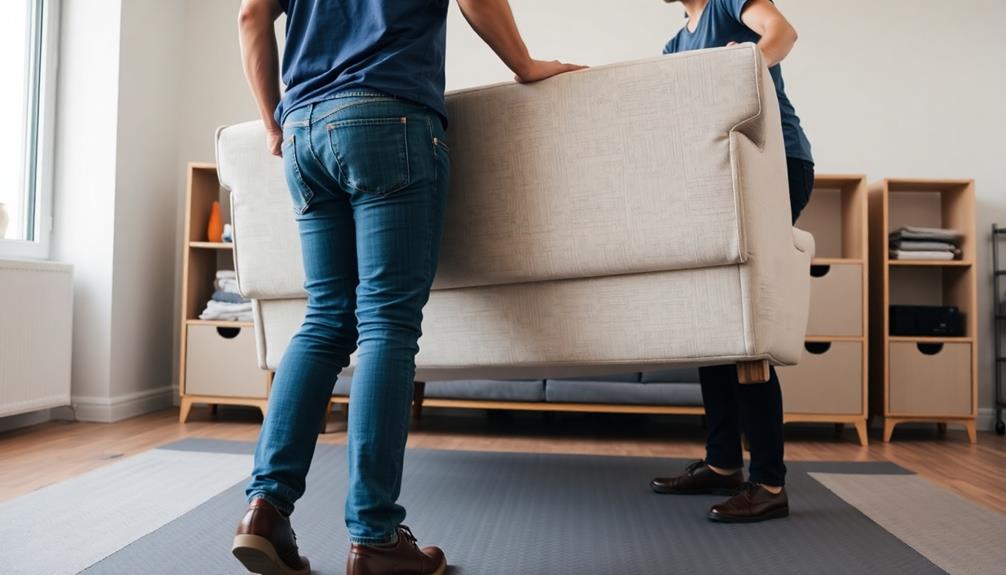
How can you lift heavy furniture safely without risking injury? First, use proper lifting techniques to protect your back and guarantee a smooth move. Always bend at the knees and keep your back straight while engaging your core muscles. This way, you'll have better stability and support when lifting.
Additionally, consider the benefits of multi-functional gear that can aid in your moving process, allowing for easier handling of heavy items.
When you're ready to lift, hold the item close to your body. This helps maintain balance and reduces strain on your back and arms. Avoid twisting your torso; instead, pivot your feet to change direction.
If the furniture is particularly cumbersome, consider using moving straps or furniture sliders to distribute weight evenly.
It's vital to communicate with your moving partner throughout the process. Make sure you both coordinate your movements to lift and carry heavy items safely.
Moving on Stairs
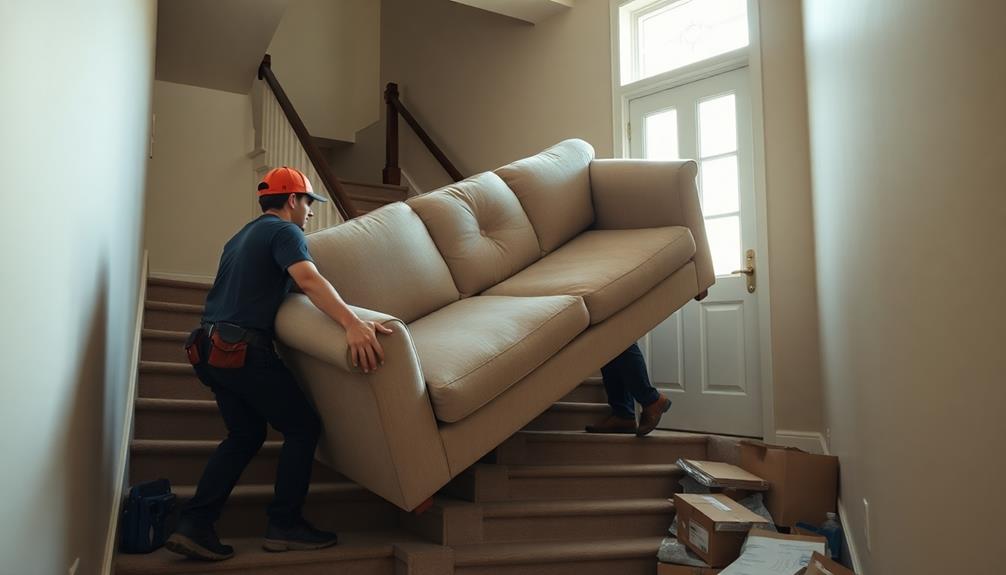
When you're moving furniture up or down stairs, teamwork is essential for safety.
Always protect surfaces by covering banisters and corners, and make sure to use proper lifting techniques to avoid injury.
Teamwork for Safety
Moving heavy furniture down a flight of stairs can feel like maneuvering through an obstacle course, but teamwork makes the process safer and more efficient. To guarantee stability and control, always have one person positioned at the bottom and another at the top of the stairs. Clear communication with your moving partner is essential, especially when maneuvering tight turns or uneven steps. When moving heavy furniture upstairs, it’s crucial to lift with your legs, not your back, to prevent injury. Make sure to take breaks if necessary to avoid fatigue, as even a momentary lapse in concentration can lead to accidents. Having a third person guiding from the side can also help ensure the item remains balanced and properly aligned.
Using a hand truck or dolly can make moving heavy items easier. Center the load and secure it with tie-down straps to maintain balance while moving up or down stairs. When you lift the item, the person at the top should guide it while the person at the bottom bears most of the weight, allowing for a smoother shift.
Here's a quick reference table to enhance your teamwork:
| Task | Top Person Responsibilities | Bottom Person Responsibilities |
|---|---|---|
| Lifting | Guide the item | Bear most of the weight |
| Communication | Signal movements | Confirm readiness |
| Breaks | Initiate breaks | Suggest route adjustments |
Taking breaks as needed helps prevent fatigue and keeps both movers comfortable with the load and stairs ahead. Prioritize safety and teamwork for a successful move!
Protect Surfaces During Transport
To guarantee your surfaces stay protected during transport on stairs, it's important to take a few simple precautions. Start by covering banisters and corners with moving blankets. This prevents scratches and dents from shifting furniture.
As you lift and maneuver items, use padded furniture straps to secure them, minimizing contact with stair surfaces and reducing the risk of damage.
When traversing stairs, always keep the heavy end of the furniture facing upward. This tactic helps maintain balance and control, which is essential for avoiding scrapes against walls or railings.
Additionally, consider installing corner guards on walls and banisters. These provide extra protection against impacts while moving large or bulky items.
During the move, regularly check your protective coverings for any signs of wear or damage. Ensuring they remain effective throughout the process is important for safeguarding your surfaces.
Use Proper Lifting Techniques
Using proper lifting techniques is vital for safely traversing stairs with furniture. When you carry heavy items up or down stairs, always have one person at each end. This guarantees weight distribution and helps maintain stability. Position the lighter end of the furniture facing down the stairs and the heavier end facing up. This setup makes it easier to navigate and reduces the risk of tipping.
Make certain to use proper lifting techniques by bending at the knees and keeping your back straight. This approach helps avoid injury while moving.
As you ascend or descend, it's essential to communicate with your partner. Clear communication allows you to coordinate movements, especially in tight spaces where mishaps can easily occur.
Consider using moving straps or furniture sliders designed for stairs to help transport heavy items more safely and efficiently. These tools can greatly improve your grip and control over the furniture, making the process smoother.
Protecting Your Furniture
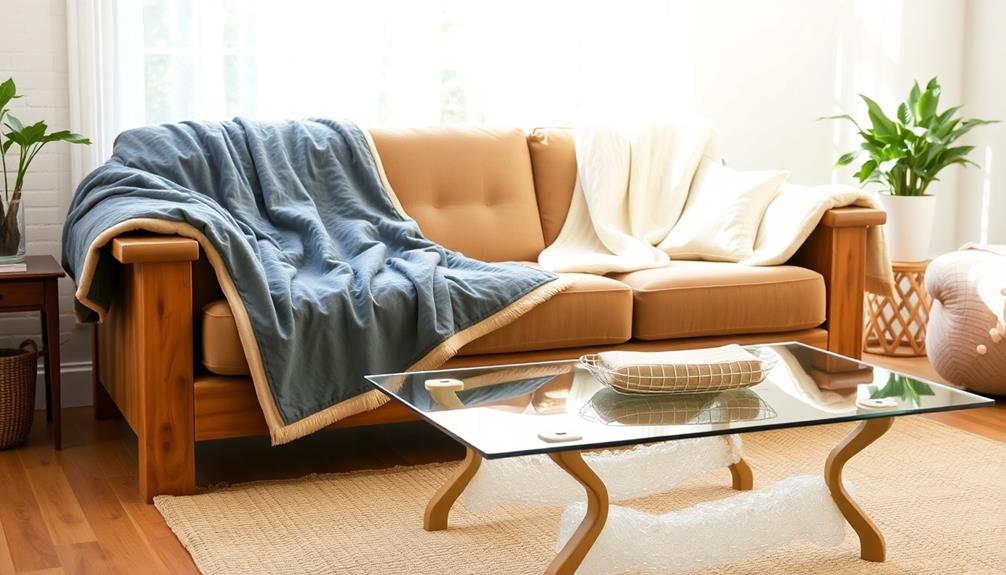
When you're moving furniture, protecting your items is essential.
Wrap your furniture in moving blankets to cushion against impacts and prevent scratches.
Then, use stretch film to secure those blankets in place, keeping everything safe during transport.
Use Moving Blankets
Moving blankets are a essential investment for protecting your furniture during transport. These thick, quilted moving blankets provide necessary cushioning that helps prevent scratches, dents, and other damage to your furniture. When you wrap delicate items, the blankets absorb impacts, ensuring everything remains intact throughout the moving process.
To maximize their effectiveness, cover all surfaces of your furniture, including corners and edges, as these areas are particularly vulnerable. Once you've covered your furniture with moving blankets, be sure to secure them tightly with stretch wrap or packing tape. This step is critical to prevent the blankets from shifting or falling off during transport.
Investing in high-quality moving blankets can save you money in the long run by greatly reducing the likelihood of costly repairs or replacements due to moving damage.
Apply Stretch Film
Protection is key when it comes to safeguarding your furniture during a move, and applying stretch film is an effective way to achieve that. Stretch film is a versatile protective material that helps you securely wrap furniture, preventing scratches, dents, and damage during transit. To guarantee maximum protection, cover all surfaces and edges completely.
Using a hand-held dispenser makes the efficient wrapping process much easier and helps reduce the risk of tearing the film while applying it. As you wrap, remember to overlap the layers by 50% to enhance stability and keep your furniture tightly secured during transport. This method prevents any shifting that could lead to damage.
Stretch film isn't just for large items; it's also great for bundling smaller items together. This makes them easier to transport and greatly reduces the risk of losing pieces during the moving process.
Utilizing Moving Equipment
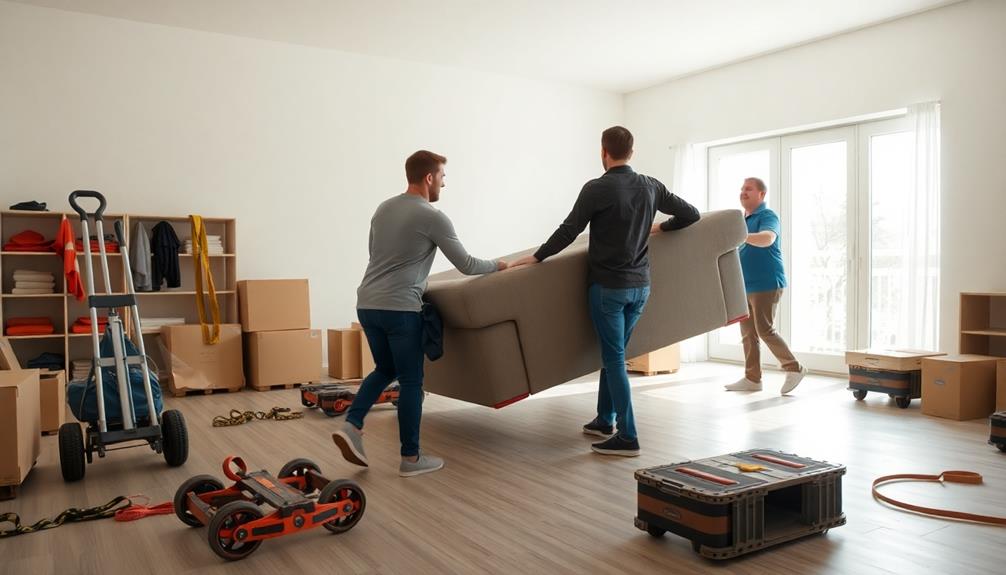
Transporting heavy furniture can be an intimidating task, but utilizing the right moving equipment makes all the difference.
Start with moving dollies, which are essential for carrying heavy furniture. They can support up to 1,000 pounds and greatly reduce the physical strain on you.
For sliding heavy items across floors, furniture sliders are your best bet. Choose hard plastic sliders for carpets and soft ones for hard surfaces to effectively reduce friction.
Don't overlook lifting straps, like the Forearm Forklift, which help distribute weight evenly. This allows you to lift heavy furniture using your legs instead of your back, minimizing the risk of injury.
Hand trucks are invaluable for stacking and moving multiple items at once. They usually support a weight capacity of 600 to 800 pounds, making them perfect for transporting appliances or several boxes.
Lastly, invest in heavy-duty moving blankets to protect your furniture from scratches and dents during the moving process. These blankets can also cover floors and walls, preventing damage in your home.
With the right equipment, you'll make transporting heavy furniture a smoother and safer experience.
Getting Help From Others

Enlisting help from friends or family can make the challenging task of moving heavy furniture much easier and safer. To tackle carrying heavy items, recruit at least two helpers to distribute the weight effectively.
Before moving day, communicate your moving plan clearly with your team, so everyone knows their roles and can coordinate movements. This is especially important when maneuvering tight spaces or stairs, where accidents can happen easily.
If you have exceptionally heavy or complex items, consider hiring professional movers. They've the experience and equipment to guarantee safe transportation, alleviating some of the stress from your shoulders.
Regardless of who you enlist to help, make certain to provide refreshments and breaks to maintain energy levels and prevent fatigue during the moving process.
Scheduling your moving day well in advance is essential. This guarantees your friends or hired help are available, reducing stress on the actual day of the move.
With the right people by your side and a solid plan in place, you'll find moving can be a smoother, more enjoyable experience.
Planning Your Route
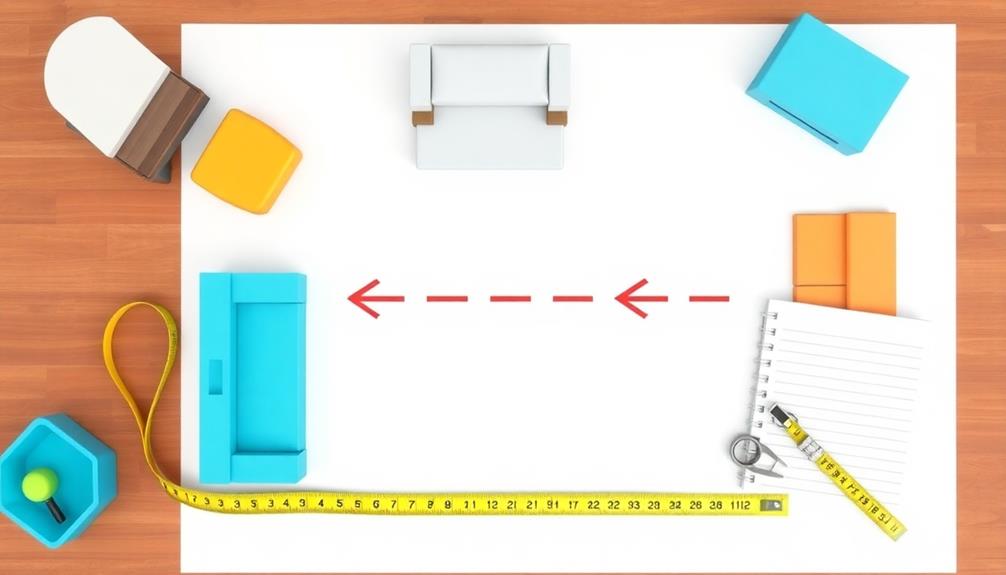
Moving furniture requires careful planning, especially when it comes to mapping out your route. You need to identify potential obstacles, like narrow doorways, staircases, and tight corners, before you start. Here's how to effectively plan your route:
- Measure: Measure the dimensions of both your furniture and the access points. This guarantees everything will fit through without damage and helps you decide if disassembly is necessary.
- Clear the Pathway: Remove any tripping hazards from your route. Loose rugs, stray furniture, or debris can create obstacles that complicate the moving process.
- Protect with Padding: Use padding on edges of doorways and corners to prevent damage to both your furniture and your home as you move.
Additionally, consider employing the L Method when maneuvering large items. This technique involves turning the furniture at an angle, allowing for easier navigation through tight spaces.
If you have furniture sliders, use them to glide heavy pieces smoothly, reducing strain on your back. By planning your route carefully, you'll make the moving process much more manageable.
Final Arrangements and Setup

After settling into your new space, it's important to focus on the final arrangements and setup of your furniture.
Start by inspecting furniture for any damages that may have occurred during transport. If you find any issues, make the necessary repairs promptly to guarantee everything looks and functions well.
Next, carefully reassemble any disassembled pieces, making sure all parts are securely attached for stability.
Now, it's time to arrange furniture according to your pre-planned layout. This will optimize flow and enhance usability in your new space.
To protect your flooring, utilize furniture coasters under heavy items. This not only prevents damage but also facilitates easier rearrangements later on.
As you position your furniture, keep an eye out for areas that may become cluttered. Dispose of packing materials responsibly to maintain a tidy environment and reduce clutter post-move.
Once everything's in place, take a step back and assess the overall layout. Adjust as necessary until you've achieved a comfortable and functional setup that meets your needs.
Enjoy your new space!
Frequently Asked Questions
How Can I Move Furniture by Myself?
To tackle moving furniture by yourself, start by gathering necessary tools like sliders and a dolly. Planning your route, disassembling larger pieces, and using proper lifting techniques will help you avoid injury and make the process smoother.
What Is the Most Cost Effective Way to Move Furniture?
To save money, utilize friends for help, rent moving equipment, disassemble large items, and schedule your move during off-peak times. If possible, use your vehicle to transport smaller pieces, cutting rental costs considerably.
How to Move a Heavy Couch?
Moving a heavy couch is like steering a ship through a narrow canal. Start by clearing obstacles, measuring spaces, and employing furniture sliders. Lift with your legs, keeping it close, and always maintain a steady, balanced partnership.
How to Move Heavy Furniture With Sliders?
To move heavy furniture with sliders, place them under corners with the smooth side down. Push from the lower section for control, and lift slightly to insert sliders. This reduces friction and protects your floors.
Conclusion
As you settle into your new space, remember that moving isn't just about furniture; it's about creating a home filled with memories. Like the journey of Odysseus, each step you took brought you closer to your destination. Embrace the challenges and triumphs, knowing you've crafted a fresh start. So, take a moment to breathe, appreciate your hard work, and let your new surroundings inspire the next chapter of your life. Your adventure has only just begun!
